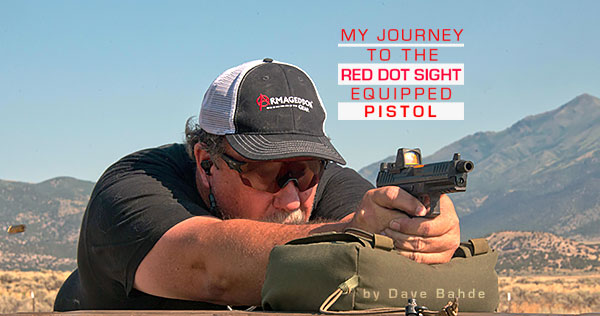
Every expert and his nearest relative has an opinion on adding a Red Dot Sight (RDS) to a pistol. Dogma is prevalent if not rampant. It will either make you the best shooter on earth, or kill you in a “real” gunfight. Like anything dogmatic, each side has prophets, most are best ignored or archived as “possibly useful minus the preaching”. Reality sits somewhere in the middle, a place I decided to find on my own – this time.
I was around when the RDS first appeared on rifles and was one of those “don’t use them you will die” types. Focused on police use, it was a gadget; iron sights ruled. Early models were unreliable and expensive. Anything that failed, even once, was a no-go for “real gunfighting”. Most officers and agencies couldn’t afford them; many still can’t. But wait, there’s more… Mired in existing dogma, my mind was closed, putting me behind the curve. Luckily, smarter people understood the potential and continued to improve it. Current top end models have survived years of hard fought battles in war, competition, or on the street. Even the most die hard “expert” who told you it was evil a few years ago now has one on his rifle. Being a “know it all” is a mistake I intended to avoid this time around so I started experimenting with Red Dot Sights on pistols a couple years ago.
Red Dot Equipped Pistols
My introduction came on a friends FN Tactical, one of the first commercially available pistols to use an RDS. Prior to that, my only use had been on a couple of purpose built open division 1911’s. Using the RMR with back up irons on a pistol purpose built for street use was intriguing. Awkward at first, it grew on me and seemed practical for a duty or tactical pistol, but I was not sure about every day carry. Next came a slide for my Glock 20 (10mm) using a Burris RDS. My ability to be accurate at 25 and 50 yards was improved significantly. Still, it could be carried concealed, but not by most, so it was time to make the rounds with the Glock G17 and G19. Neither fit me particularly well. Using a Timberwolf frame helped quite a bit and provided a better idea of using the pistols for everyday carry with an RDS. My Smith and Wesson M&P was a solid candidate, but I did not want to alter it since it worked well without an RMR. Because no one sells finished slides, it was time to try something different.
HK VP9 with Ashbury Precision RMR Installation
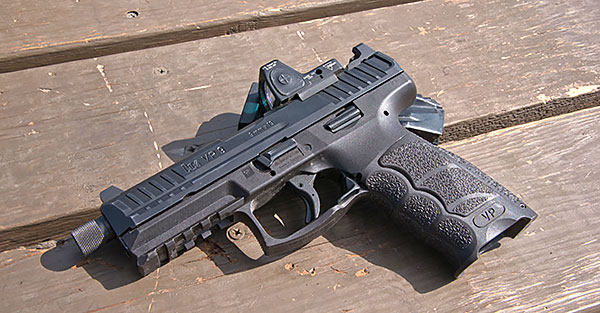
I had just acquired a new Heckler and Koch VP9 it was proving to be a fast favorite. Close in size to a G19 it was reliable, accurate, and the ergonomics were outstanding. Very soft shooting, even with +P ammunition, it seemed like the perfect candidate for this project. It would be outfitted with a Trijicon RMR along with a threaded barrel for suppressor tests, back up iron sights, and used for carry, training, and teaching duties at Gunsite Academy.
The only question was where to get the work done. It’s not like everyone does this work, and the last thing you want is someone inexperienced cutting up your slide. Working through my contacts, the perfect company popped up, Ashbury Precision. Ashbury Precision Ordnance builds some fantastic precision rifles and the chassis systems to support them. Their attention to detail is superb. Every APO chassis gun I’ve tested has been accurate, and built to custom standards. Turns out they have a custom shop, one with extensive experience working on HK pistols. They offered a conversion for the VP9 that was perfect. The slide is altered to accept a mount, then the RMR. It includes a cover plate that fits flush so the pistol can be used without the RMR if needed. They can also add Heinie Slant Pro Straight Eight Suppressor sights with tritium inserts. Given this pistol’s multi-purpose role APO was perfect. I shipped The VP9 along with the Trijicon adjustable LED RMR to get the work done. When they were returned a couple months later, the fit and finish were excellent. Sitting just in front of the Heinie sights (they use the factory dovetails) they co-witnessed the RMR perfectly. Cerakote matched the original slide finish. Everything fit well and lined up. Ashbury sights the pistol in and tests it prior to shipping making it easy when you hit the range.
The VP9
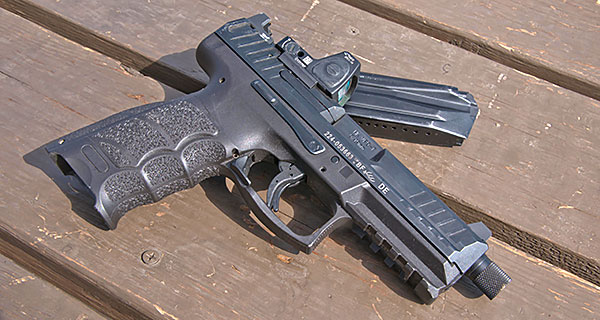
My VP9 has been around for more than a year and has turned into my favorite polymer pistol. It’s yet to fail using all sorts of ammunition. Soft shooting, even for a 9mm, it’s very accurate. Controls, including an ambidextrous slide stop, are easy to access. The magazine release takes some getting used to but once dialed in it is fast. Having carried an HK USP years ago, it only took a few rounds to get back up to speed. Overall size is about perfect for multi-role use. Capacity is 15+1 making it suitable for duty work. Ergonomics are among the best available. It fits my hand like no other polymer pistol. Side panels and grip straps can be changed to get the perfect fit. Trigger is smooth and crisp minus the stacking seen on other designs. Thanks to companies like HK Parts you can get most anything available in the aftermarket. It carries the typical HK price tag, but you can get it, not something HK is generally known for. Magazines are metal with solid base pads and holes to indicate capacity at a glance. With just a bit of looking you can find a VP9 comparably priced to its competitors, I paid $545.00 for this pistol from Prepper Gun Shop.
Testing
This is more about testing an RDS equipped carry pistol than the VP9. It’s been tested thoroughly, nothing new there. But few are RMR equipped, and my mindset was to decide for myself if it was worth it. Reviews on a pistol with an RDS are like computer reviews, wait a week and it will change. It was time for me to spend personal range time in various conditions.
It is also important to note my age, 57, so my front sight has not been “crisply focused” for a decade or so. It adds another dimension to the equation that a young steely eyed 30 year old may not experience. It’s also about every day carry, range work, training, and duty use. Almost all of the testing was completed using Barnes Bullets 115 grain +P TAC-XP. It’s a great all around bullet that works well through media and shoots flat. Barnes still loads ammunition to a standard most main stream companies can’t or won’t match, so it has been my preferred carry round for quite some time. Since this is about my carry gun it was used almost exclusively.
Accuracy

If an RDS does nothing else on a pistol it makes traditionally long shots (25 yards and beyond) exponentially easier, much faster, and more accurate. I am no slouch with an iron sighted pistol to begin with but the RMR made it down right simple. I zeroed on a bench using a bag as a rest, slow fire, getting as close to center as possible over several sessions. I settled on 40 yards after playing with different zeroing ranges. Several sessions later I was able to keep all my shots in a fist sized target from muzzle contact to 50 yards.
My best group from the bench at 25 yards without the RMR was in the two inch range. With the RMR I could match that shooting off hand, repeatedly. Getting 15 out of 15 hits on a 6” round steel target was almost boringly easy from off hand at 25 yards. On the move it was not much different – dot on target, press trigger, bang steel. Add the stress of a real fight and the group will get bigger, especially if someone is shooting back. It always does, but I would not hesitate a second to take shots at that range on the move if needed. During the zeroing process my best group from 40 yards was about the same, not something normally achieved without the RDS, even with my custom 10mm pistols.
Drawing to target at closer range (10-15 yards) it was possible to stack rounds on the dot with solid speed. No slower than using irons, but much tighter and once dialed in, faster. Moving towards the target using the RDS it was possible to get on a hostage taker target faster, take the shot quicker, and do so with better hits. Was it exponentially better? Not really, but it was better, and in the real world that could be huge. All said and done, accuracy was improved, and the greater the distance, the greater the improvement.
Speed
Pretty much the same thing, the greater the distance, the more the advantage. At arms reach there was no difference, mostly because I don’t focus on the sights at that distance. After years of training it’s pretty much threat focused up close. Step back a bit, even to seven yards and once I figured it out, shooting with the RDS was about the same, maybe quicker at times. If sights were going to be used the RDS was faster with practice. The key was to shoot exactly the same way as before without altering my presentation or focus. The pistol presents the same way it has for three decades, there is just a dot to see, and it is there a fraction of second before the front sight. Nothing to line up, if the dot is on so is your shot. Shooting one handed from either side was much better with the RDS. From the ground, behind barricades, under the car, anything where sight alignment was not possible the RDS provided a huge advantage.
Just as a training note, looking for the dot slowed me down considerably. Having heard this already, practice proved it true. Using that method (looking for the dot) for an entire department shoot it was much slower, frustrating in fact, and difficult to be accurate. Reverting back to standard practice it was no slower, often faster, and generally more accurate and precise. Will it turn you into a Top 10 speed shooter? Sure, coupled with 10K rounds a week down range, about as much dry practice along with hundreds of competitions and a decade or so you will be good. What it may do is make you marginally faster than you were to target, and the more you practice the better it is.
Carry Comfort
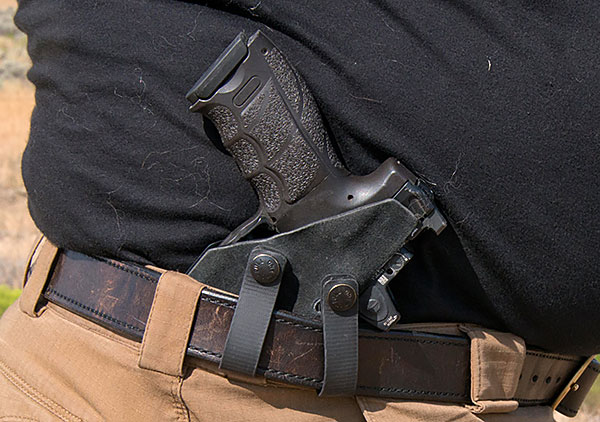
Having carried several RDS equipped pistols now the idea it is somehow problematic to conceal, uncomfortable, or slower to draw has just never played out. You need to get a good holster. Even carrying a G19 with an RMR using appendix carry there was no difference. If the RDS is cut into the slide it’s just never made a difference (note: ‘skinny’ is not used during any recent description of me). Using an NSR Tactical LLC-4 IWB holster this pistol is carried every day and has been for months. While altering the top to accommodate the RMR was needed (rather than order a new one), it even accommodates the threaded barrel. It fit in both my NSR standard holsters (light or no light) without alteration. Over a couple years now carrying four different pistols with an RMR, including a 1911, there has been all but zero difference. Add an RMR to your current carry pistol and it is unlikely you will notice it while carrying after a few days.
Reliability and Operation
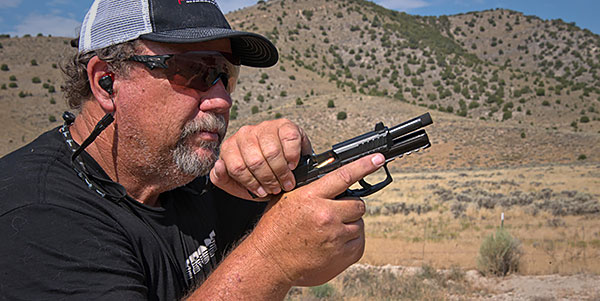
Zero difference here, the VP9 works exactly as it did before with all the same ammunition. The only thing you need to be careful of is using the RMR as a lever to rack the slide. While it can be done, it should be avoided. Rest your palm over the sight grasping the slide, just like you would if it were not there. Failing to do so over time only makes it more likely it will come loose. Ashbury did an excellent job here as my RDS has yet to come loose from the day it was taken out of the box. No idea what the ammo count is, thousands for sure and it is still tight. That has not been the case with others, so it pays to check. The Henie sights have a ledge that can be used for field expedient slide operation. It takes some practice, but can be done. In a pinch, in a fight, it should not be an issue, but it’s not a good idea to make it a regular practice. Over months of use along with bouncing around in the back of the truck, there has been no change in my zero. Still, it is ALWAYS mandatory to confirm zero on any red dot or optic on any pistol carried in harms way regularly. Mine are checked every week as a rule.
Final Thoughts
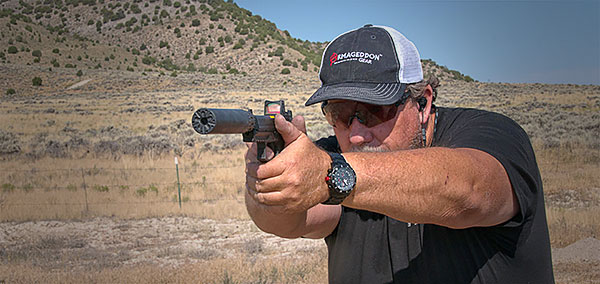
Yes, it was easier for my old eyes to find the dot. The adjustable LED worked well. It’s nice to dial up or down as needed. Battery is still working since it arrived almost three years ago. Changing battries yearly, along with regular testing should eliminate concerns, but that argument will never die. Just another reason for BUIS or carry pistols. Present as usual, if the dot is not there the front sight will be.
Is the RDS perfected for the pistol? Absolutely not! But, it has improved to the point where it provides tangible advantages for many. Cost and the need to alter your slide has been the biggest hurdle but that is changing. Manufacturers are accommodating RDS mounting from the factory. Precut slides are growing in popularity as well. Even the 1911 is seeing use given the excellent Trijicon mounting system. Gunsmiths that can expertly alter your slide are popping up all over. That’s going to get better, it’s getting easier to mount an RDS to your pistol, and to me that’s a good thing.
Innovation is the life’s blood of every aspect of the gun industry, including training. Thirty years of experience as a student, trainer, and gunsmith has proven that to me. Listen to some of the “experts” and we would still be figuring out how to fit clubs in our holsters. Just because it’s new does not mean it won’t work. Truth is, it may save your life. That makes it more than worth the time and money investment. If there has been one downside to this test, it’s the fact the cover plate will never get used, because the RDS is not coming off this pistol anytime soon!
EoTech’s MRDS (Mini Red Dot Sight) Review >>>
More Red Dot Sight Stories >>>
Dave Bahde completed a storied career as a police officer. Today he is a full time gun writer, trainer at the legendary Gunsite Academy, hog hunter and friend of SHWAT™. Have a story to share? Contact us >>>



Thank you for the great review of the VP9 RDS. I’m just new to handguns but trying to learn all I can and this had some very useful info in it. I’ve only fired a Glock 17 with a RDS on it from the range I use and I must say the first time I wasn’t sold on a RDS but that was most likely due to the newness of the type of sighting. Since then it has become more intriguing and the VP9 (SFP9 in Canada where I’m from) will be my first purchase.